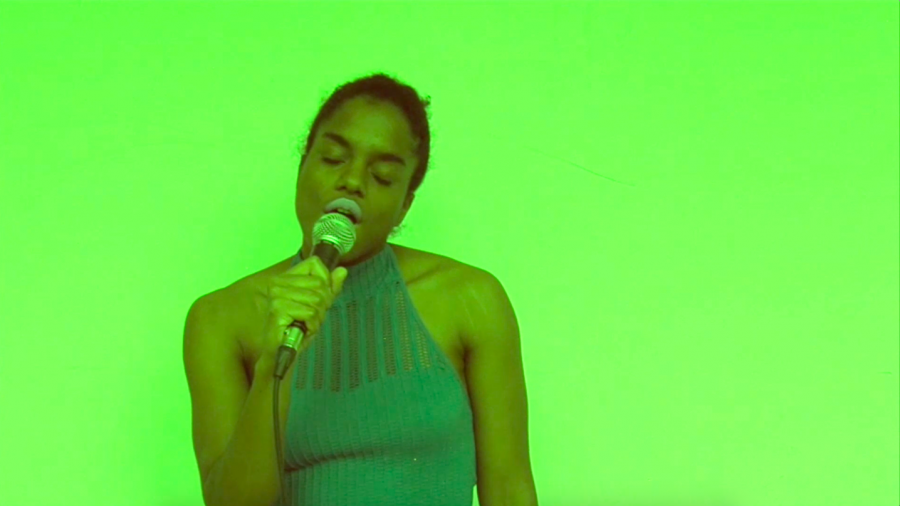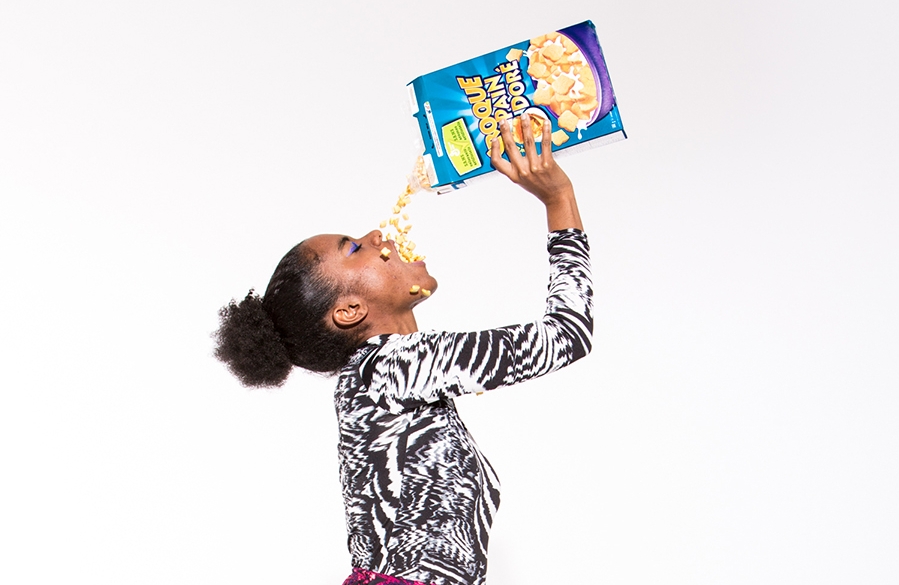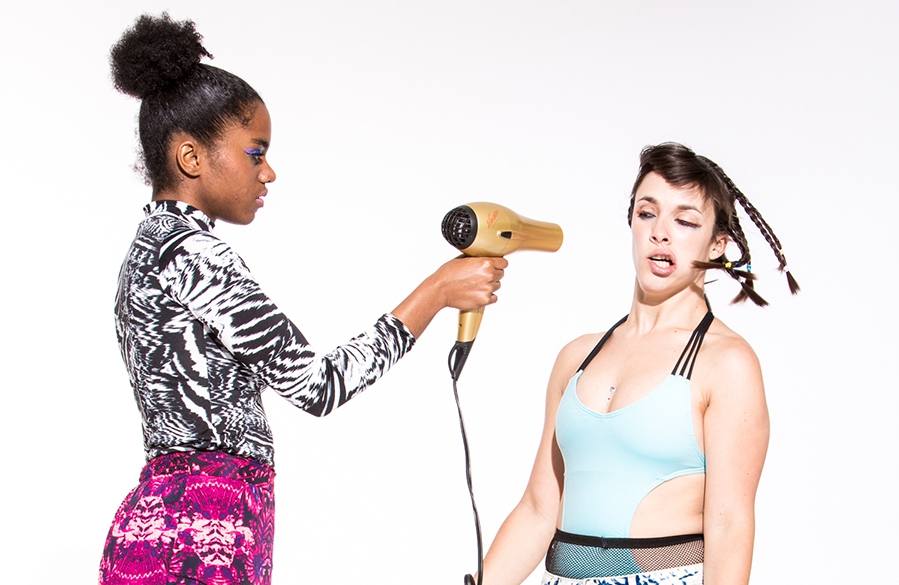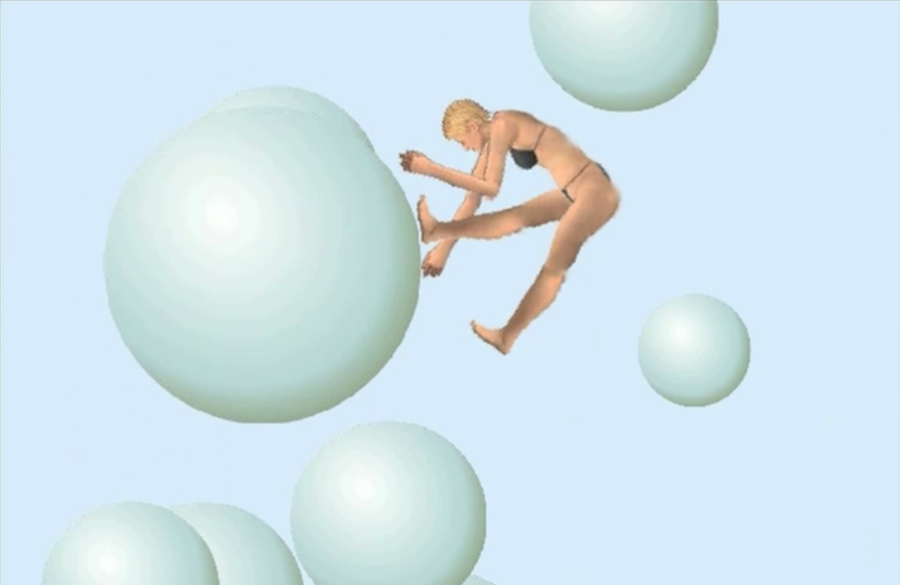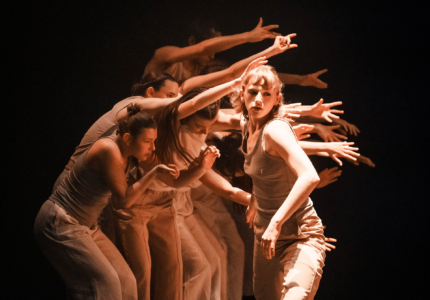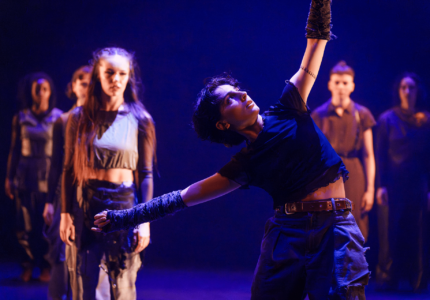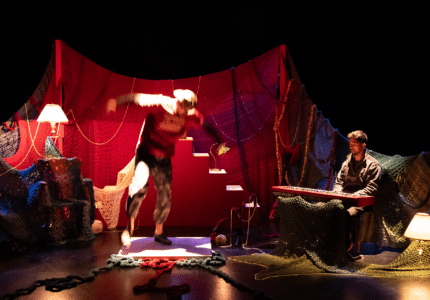Double bill
Geneviève Jean-Bindley + Freya Olafson
FEBRUARY 14. 15. 16, 2019 - 7:30PM
FEBRUARY 17, 2019 - 4PM
-
WARNING: THIS SHOW INCLUDES STROBOSCOPIC EFFECTS
-
DISCUSSION WITH THE ARTISTS AND BOOK TABLE ON FEB. 15
Geneviève Jean-Bindley
Ne me dis pas que tu m’aimes
A karaoke bash. A pool party. A night at the club. But really a musical comedy set to Navet Confit’s songs. This deconstructed dance is a patchwork of contemporary jazz, a colourful pop aesthetic, synchronized swimming, animalistic movement, artificial gestures, absurd texts, soft melodies, and overconsumption of stuff. We’re talking about the psychology of consumption. Where are we going with this? Will we come out winners or losers? A symbol of eternal dependence, a luxurious stuffed dog keeps popping up. This is serious.
Choreography and artistic direction Geneviève Jean-Bindley
Performance Marie-Ève Dion, Élisabeth-Anne Dorléans, Myriam Foisy, Jacinthe Léger-Leduc, Marie-Philippe Santerre
Musical arrangements and voice coaching Carl-Éric Hudon
Music Navet Confit
Lighting design Gaspard Philippe
Video design Daniel Bindley
Outside eye Sophie Michaud
Geneviève Jean-Bindley is from Chicoutimi and has developed her love of dancing during her ten years of classical ballet training at the Académie de Ballet du Saguenay. Attracted by other art forms, she continued her studies at Cégep de Chicoutimi and du Vieux Montréal in visual arts. Obsessed by everything visual – drawing, photography, advertising, painting, television – she has developed her approach and acute love for the visual arts since she was very young. She never lost her passion for dance and registered at Université du Québec à Montréal for creation/performance in contemporary dance, from which received her diploma in 2014. Geneviève is a visual artist to her very core, leaning on choreography for support and the body as material. Her choreographies are a staging of harmonious and sequential images that create a unified whole. It’s not just the gesture that is almighty for her, but the gesture in the entirety of surrounding space. It is from this marriage that the sense and interest in movement becomes visible and sensitive. Her choreographic creations have been shown at Zone Homa, VSLR, Tangente, Off Québec, Fringe, les Nuits Émergentes de Sudbury, and more.
Jacinthe Léger-Leduc has a bachelor’s degree in Contemporary Dance from Université du Québec à Montréal. Theatre is her first love. After completing her DEC in Dramatic Arts at Cégep de Saint-Laurent, she returns to her biggest passion, dance, and registers for the performance program offered by the UQAM Department of Dance. In university, she explores the works of Nicolas Cantin, Dominique Porte, and Estelle Clareton, in addition to working with choreographers such as Frédéric Gravel, Danièle Desnoyers, and Virginie Brunelle.
Elisabeth-Anne Dorléans has a bachelor’s degree in the dance performance profile from UQAM. In university, she collaborates with choreographers such as Sasha Kleinplatz for the remount of L’Échauffement at F-OFF and Danièle Desnoyers for the Do It exhibit at the UQAM Gallery and for Anatomie d’un Souffle. In addition to performing, she pursues a master’s degree in Dance at UQAM. Her research focuses on cultural diversity in contemporary dance.
Marie-Ève Dion actively contributes to the Montréal art scene and is a graduate from the UQAM Contemporary Dance Performance program. She dances primarily for GEANBINDLEY Art and BLACK HOLE – choreographic arts in collaboration with several emerging artists. She also works with choreographers such as Chloé Bourdages-Roy and Claudia Chan Tak, in addition to the collective she belongs to, S’Enfarger, with Myriam Foisy, Anne Cormerais, and Jean-Benoit Labrecque. Marie-Ève is also passionate about the visual arts, most especially photography. Her artistic approach focuses on the dancing body and is inspired by the urban architectural environment. Among others, she collaborates with performer Baily Eng as photographer and outside eye.
Marie-Philippe Santerre graduates in Dance Performance from UQAM in 2013. She works as a performer with several emerging choreographers such as Alex-Ann Boucher, Philippe Dandonneau, Helen Simard, and more recently Geveniève Jean-Bindley. She explores collective creation in 2015 with Chloé Ouellet-Payeur for Essai #2, presented at Théâtre d’Aujourd’hui as part of Festival St-Ambroise Fringe Montréal. She does choreography in 2017 for the Dans son salon company and with Chloé Ouellet-Payeur for Vuela Vuela: La Danse, which is part of Jouer Dehors in 2018-2019. She is an intern for choreographer Catherine Gaudet from the Lorganism company for a new creation presented in Montréal in 2018.
Navet Confit has created odes to meaninglessness for a dozen years by giving an inordinate amount of importance to the futile with music that oscillates between light heaviness and heavy lightness. The lyricist and multi-instrumentalist is passionate about working in the studio (sound, mixing, arrangements) and produces his own albums as well as those of other artists. Navet Confit likes to add textures to his sound just as he likes to play with words to create a controlled fog that encourages an open interpretation of his songs, which are often performed quite differently live. In 2011, after several albums, the artist dives into the world of theatre as a composer, a sound designer and/or a live musician (Clotaire Rapaille, l’opéra rock, L’Assassinat du Président, Peer Gynt and Yukonstyle, among others), and founds the Théâtre du Futur along with Olivier Morin and Guillaume Tremblay. In 2017, Navet contributed his first soundtrack for a feature film.
Carl-Éric Hudon has been living and working in Montréal for just over a decade. He has released three folk albums under his name, two others with Panache, his grunge pop band, in addition to accompanying several Montréal-based artists both in the studio and on stage (Navet Confit, Géraldine, Moussette…). A jack of all trades, he also occasionally collaborates as a composer/musician/sound designer with contemporary dance and theatre artists (GEAN BINDLEY Art, Festival du Jamais Lu, Maribé – Sors de ce corps).
Gaspard Philippe is born in Switzerland in 1993. He graduates from Lycée Cantonal de Porrentruy in 2012. He then takes a flight to Québec in 2013 to study theatre at Université Laval. He is then accepted at the National Theatre School of Canada in the Production program. During his training, he works with directors such as Jocelyn Pelletier, Philippe Cyr, and Florent Siaud. Newly graduated, Gaspard is now working on different theatre and dance productions. Although his passion lies in sound design, he’s also interested in lighting and video. He has recently worked with Andrew Turner as a lighting designer for 18 P.R.A.C.T.I.C.E.S and with Jean-Simon Traversy as sound director on the last production of La Roulotte.
Josée Lecompte has always loved drawing, building and creating. She was particularly fond of art, graphics, and photography during high school. It was when she completed her studies in Visual Arts (Bachelor’s degree at UQAM and DEC at Cégep Lionel Groulx) that Josée developed her passion for photography and immersed herself in technical photography at Cégep du Vieux Montréal. She has since been practicing photography in Montréal and specializes in fashion and portraits of all styles. Josée is inspired by the Montréal music scene and thrives on photographing musicians in their everyday life and onstage. She works as much with artists and corporate entities as she does with magazines.
Ne me dis pas que tu m’aimes is a “musical choreography” inspired by Navet Confit’s songs. An exploration of emotional extremes. An examination of the thin line between vulnerability and modesty. Is loss of control interchangeable with the objectification of our true feelings?
In a living room decor where karaoke reigns, we drink, we dance, we kiss, we speak, we laugh, we smoke, we shout, we sing, we cry, we live it up, or at least pretend that we do. We consume everything that we feel and we reveal what we wish would remain hidden. We reach a secondary state of comfort. One that is fast, excessive and superficial, but we are at one with ourselves. We let go but we go too far. Ne me dis pas que tu m’aimes is a choreography tainted with curiosity that is as equally rational as it is artistic. It exaggerates situations, denounces taboos, and underlines a reflexion through the absurd. It explores feelings that we often find unappealing to unveil their true beauty and to showcase humanity.
Freya Olafson
Release Technique
While injured, Freya was investigating digital bodies when she came upon the free online game platform Falling Woman, which called to mind Skinner Releasing Technique. She was thinking about the limits of the body, labor and ready-made movement, and looking at methods of training and disciplining bodies. This exhausting and exhilarating study of the body’s relationship to gravity in cyberspace will either strike you as soothing or make you queasy. This video is part of the Keystroke Choreographies series.
Creation Freya Olafson
Freya Björg Olafson is an intermedia artist who works with video, audio, painting, and performance. Her praxis engages with identity and the body, as informed by technology and the Internet. Olafson’s work has been presented and exhibited internationally at venues such as the Bauhaus Archiv (Berlin), SECCA – SouthEastern Center for Contemporary Art (North Carolina), Ochoymedio (Quito, Guayaquil and Manta, Ecuador), The National Arts Centre / Canada Dance Festival (Ottawa), and Onassis Cultural Center (Athens, Greece). Her video work has screened in festivals and galleries internationally, and is distributed by Video Pool Media Arts Centre. Olafson has benefitted from residencies, most notably through EMPAC – Experimental Media & Performing Arts Center (New York), Oboro (Montréal), and Counterpulse (San Francisco). Olafson joined the Dance Department at York University as Assistant Professor with a speciality in screendance in July 2017.

